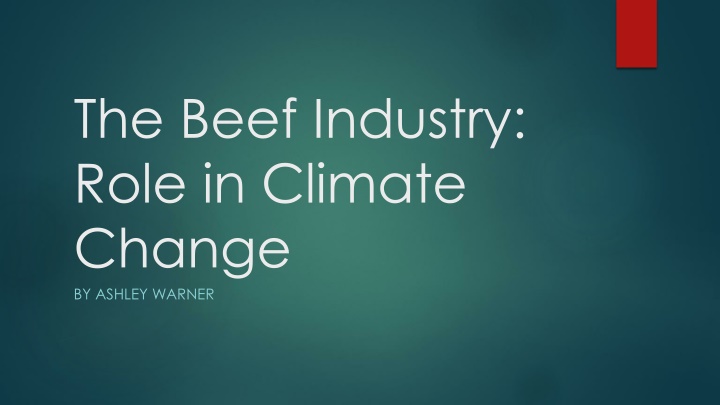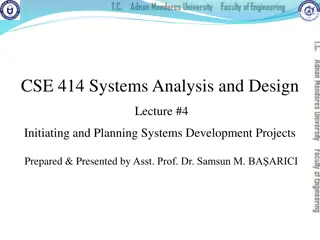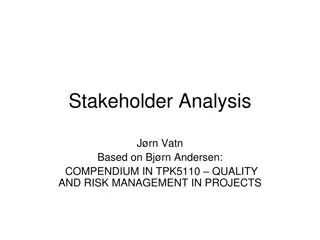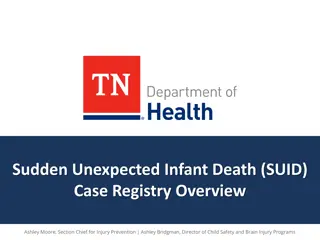
The Environmental Impact of Beef Production Systems
Explore the significant role of the beef industry in climate change, highlighting the environmental impact of different beef production systems such as conventional, natural, and grass-fed. Discover how reducing meat consumption can contribute to carbon savings and the implications for the environment.
Download Presentation

Please find below an Image/Link to download the presentation.
The content on the website is provided AS IS for your information and personal use only. It may not be sold, licensed, or shared on other websites without obtaining consent from the author. If you encounter any issues during the download, it is possible that the publisher has removed the file from their server.
You are allowed to download the files provided on this website for personal or commercial use, subject to the condition that they are used lawfully. All files are the property of their respective owners.
The content on the website is provided AS IS for your information and personal use only. It may not be sold, licensed, or shared on other websites without obtaining consent from the author.
E N D
Presentation Transcript
The Beef Industry: Role in Climate Change BY ASHLEY WARNER
Meat the Truth In 1 year, a cow in the Netherland s will produce just as many green house gas emissions as a car that drives 70,000 km, equivalent to driving 1.5 times around the globe. Half of global wheat harvest is used to feed livestock. To produce animal products, 10x more land is needed than to produce vegetable products. U.S. factory farming of meat uses 1/3 of fossil fuels generated in the U.S.
Meat the Truth HOW MUCH CAN A REDUCTION IN MEAT CONSUMPTION CONTRIBUTE TO CARBON SAVINGS? If all U.S. residents cut meat intake by: 7 days = 700 Mt of greenhouse gas emissions ~ remove all cars from the road in America 6 days = total electricity use of all U.S. households 5 days = carbon savings equivalent to planting 13 billion trees and letting them grow for ten years ~ 43 trees per American 4 days = half the domestic use of all electricity, gas, oil, petrol, and kerosene in the U.S. 3 days = 300 Mt greenhouse gas emissions ~ greater impact than if all cars in the U.S. are replaced by Prius 2 days = replacing all household appliances with energy efficient appliances 1 day = 90 million plane tickets from New York to Los Angeles
3 Beef Production Systems 1) CONVENTIONAL finished in feedlots with growth- enhancing technology (steroids, hormones, antibiotics, etc.). Majority of beef operations. 2) NATURAL finished in feedlots without growth- enhancing technology 3) GRASS-FED forage-based diet from birth to slaughter without grain or other non-forage supplementation. No growth-enhancing technology
Study Environmental impact calculated by comparing annual resource inputs and waste output of each beef production system. Expressed per 1 billion kg of beef produced in 365 days Calculated using AMTS Cattle Pro software. Computer modelled result.
Production System Comparisson Conventional Natural Grass-fed Average slaughter weight 569 kg Average slaughter weight 519 kg Average slaughter weight 486 kg Lifespan 444 days Lifespan 464 days Lifespan 679 days 7,046,000 cows to produce 1 billion kg of beef 8,257,000 cows to produce 1 billion kg of beef (17.1% increase) 12,510,000 cows to produce 1 billion kg of beef (77.5% increase) Transported ~483km between sub-system, 161km to slaughterhouse (644km) Transported ~644km Transported ~161km from farm to slaughterhouse Feed transport ~558km Feed transport ~558km No feed transport Requires 22.4% more land than CON Requires 80.8% more land than CON 17.9% increase in water use 302% increase in water use 67.5% increased carbon footprint compared to CON
Discussion What beef production system do you think is the best option? Why? Do you think beef is a sustainable food source? The outcome of the study concludes conventional beef production systems as the most sustainable method in beef production. In this scenario, how do you feel about consuming beef that has been treated with growth-enhancing technology? Should the beef industry continue to intensify and improve productivity using conventional methods, to feed increasing population or adopt extensive production systems such as grass- fed methods? Other possible solutions? Do you have a problem with the way cows or animals are treated during factory farming practices? 1) 2) 3) 4) 5)
References Capper, Judith L. 'Is the grass always greener? Comparing the environmental impact of conventional, natural and grass-fed beef production systems', animals, vol. 2/no. 2, (2012), pp. 127-143. https://www.youtube.com/watch?v=hHCCFjB8M48 United states. Congress. House. Committee on agriculture. Subcommittee on livestock, dairy, and poultry (2007-2012). , 'Hearing to review the state of the beef industry: hearing before the subcommittee on livestock, dairy, and poultry of the committee on agriculture, house of representatives, one hundred twelfth congress, first session, April 6, 2011', anonymous translator(, Washington, U.S. G.P.O, 2011).


















![Project Initiation Document for [Insert.Project.name] [Insert.Project.number]](/thumb/226757/project-initiation-document-for-insert-project-name-insert-project-number.jpg)



